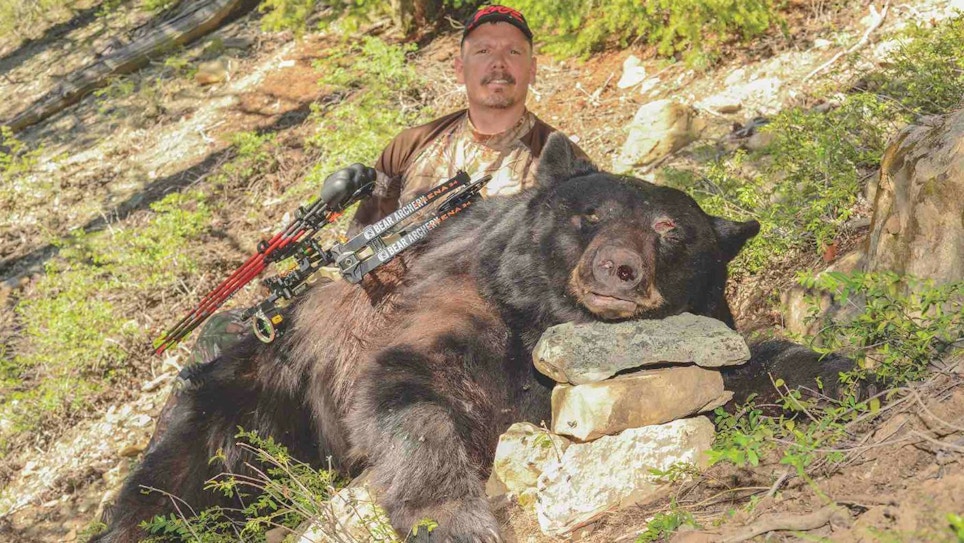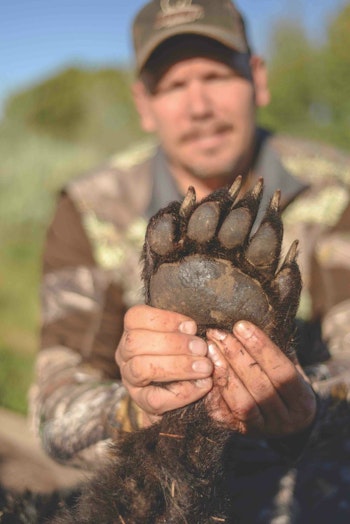
A DIY black bear bowhunt out West is rarely easy. After nearly a week, this old western battler finally slipped within the author’s range during daylight hours.
It’s funny how we evolve as bowhunters. For 20-plus years now, I have spent countless weeks out West come September with a pocket full of tags and seasons full of dreams. Although some years the tags were still riding with me when I returned home bruised and beaten, looking back I suppose I fared pretty well. Regardless of the outcome, it wasn’t so much the animal I was pursuing that made the lasting impression but the overall experience the endeavor provided.
Like many blue collar western bowhunters, mule deer, elk and antelope have been the meat and potatoes of my experiences, with the occasional western whitetail sprinkled in for good measure, and rightly so! These ungulates are not only plentiful and inhabit large chunks of public dirt, but the wild places they call home, coupled with their impressive headgear, survival instincts and top-end table fare are what drives most of us to punish our bodies and fill our adventurous spirit. Although my drive to bowhunt such game is still strong, over time my eyes, as well as my passions, have turned towards another season that I was ashamedly overlooking.
I guess I was just like most guys who hunted out West. I looked at black bears as more of a secondary opportunity. In fact, Ursus americanus was not even on my radar when I first picked up the bow and arrow. I always had a tag, if I remembered to grab one. However, other than the occasional black bear I spotted off in the distance while chasing mule deer or elk in my home state of Colorado, I never gave them much of a thought. My affections changed many years ago when I had a close encounter one September evening.
Realizing my chance at a particular bull had slipped through my fingers, I sat in a grove of aspens contemplating my next move. I was down to the last few days of the season and was beginning to wonder if my elk tag would go unfilled once again when I caught movement. I naturally thought it was an elk at first and quickly threw up some glass for a closer look. However, when the raven-black hide glistened in the evening sun, I knew better.
For several minutes, I watched as the bear fed lazily in a small clearing within a patch of wild raspberries less than 100 yards away. In a matter of seconds, elk quickly took a backseat. Although I didn’t have a bear tag to fill, I was mesmerized in the moment. Even with my unexperienced eyes, it was easy to distinguish that this was a mature boar; his blocky body and pumpkin-sized head revealed as much. Seconds turned into minutes, and when he turned and began feeding in my direction, our eyes eventually met. My heart pounded as his coal-black eyes seemed to burn a hole right through me.
He was close — too close I thought at the time. He knew something wasn’t quite right. Unsure of what I was, he took a couple cautious steps in my direction with nose in the air, and then raised on his hind legs for a better look. My 6.5-foot frame seemed so small in that brief moment and I quickly realized that man is not in complete control of the natural world around him. At just a stone’s throw away, our eyes were glued on each other. I stood nervously as I waited for him to make the next move. Like all encounters with wild things, this one came to a sudden close when the capricious mountain breeze gave me away. Before I could blink, he dropped to all fours and bolted out of sight.
As I walked off the mountain that evening, replaying the events of the day, I knew that black bears would soon find their way into the mix every season. Since that time, I’ve hunted bears in several states and in as many Canadian provinces. Although each experience has been different, all have deepened my affections for these iconic western big game animals.
If you have longed to add another experience to your bowhunting quiver, it’s hard to beat what a late-spring black bear hunt offers. Not only are bears active during daylight hours, but as the weather warms, the rut heats up and big boars are on the move. For the DIY bowhunter looking for a quick fix, as well as a challenge, western black bears are a great option. With numbers plentiful, opportunities ripe and tags over-the-counter in many regions, there’s just no excuse not to go. Furthermore, there’s just something special about being face-to-face with a mature boar. Sure, turkeys are fun, but in my opinion the iconic western black bear is the true king of spring! And now is the perfect time to begin planning such an adventure.
Don’t be fooled by what some say; black bear hunting is rarely easy. They have a remarkable sixth sense and an even better sense of smell. And what their eyesight lacks, there other senses more than makes up this shortcoming. It often takes a lot of work and even more patience to find success, and when you add the DIY factor, it only compounds the difficulty. Without question, this endeavor is a true western challenge.
To get your planning started, I’ll discuss three of my favorite DIY black bear destinations.

The Gem State
For sheer opportunity, as well as a variety of methods in which to hunt, no other state offers what Idaho does. Whether you opt to guard a bait, which seems to be the primary and most productive method, glass country for a spot-and-stalk hunt, use a predator call or employ a good set of hounds, all can be utilized effectively.
Idaho’s generous season structure runs from mid-April to late June in many units, and with the vast majority of them offering over-the-counter tags at just $186 for the non-resident, and some northern units a second tag for just $41.75 because of the high numbers, Idaho is a bear hunting “gem.” Although it’s not known for B&C toads, what it lacks in trophy heads it more than makes up for in overall bear numbers.
Big Sky Country
Montana has clearly become a hotspot for bear hunters looking to stretch their legs, as well as their lungs in search of black bears. Unlike its neighbors to the east and west, baiting is off limits, so too is the use of hounds. That being said, matching wits with Montana bruins requires lots of time behind the glass and a sneaky approach. Many hunters will employ a predator call once a bear is spotted in an attempt to coax one in close. The key to locating bears is working a lot of country efficiently until you find one in the perfect position. Follow the snow line up and concentrate your efforts on south facing slopes. Hunting gated logging roads is an excellent option as well, and if you have one, bring your mountain bike to cover a lot of ground. Finding access is key to any DIY hunt, so spending time using onX Maps (www.onxmaps.com) is a great place to start.
Montana FWP estimates there are over 15,000 black bears roaming the state, with the vast majority living in the northwest region. Although it’s not known to produce giant bears, since the mid-1990’s Montana’s annual black bear harvest ranks pretty high for the Lower 48, behind Washington, Oregon and Idaho most years. With an over-the-counter non-resident tag just $350, it’s hard to beat the true western experience that Montana offers.
The Cowboy State
Rounding out the list is Wyoming. Big bears live in Wyoming and with over-the-counter tags just $373 for the non-resident, it is an excellent destination if you’re wanting a DIY hunt. Although many bowhunters prefer baiting black bears in Wyoming, spot-and-stalk opportunities in high country regions like the Wind River Range can also be embraced. In 2017, the highest success rates came from the Sierra Madre, Green River and Burgess Junction regions.
Keep in mind that Wyoming’s bear season is based on a female harvest quota, and the season will close in each individual unit once the quota is reached. Also, be aware that the northwest region is grizzly country. Because of this baiting is not allowed in areas 22, 25, 26, 32 and parts of 23 and 27. Baiting is also not allowed in wilderness areas throughout the state. Wyoming’s spring archery bear hunt runs from mid to late April, while the gun season starts in early May and runs through mid-June.





